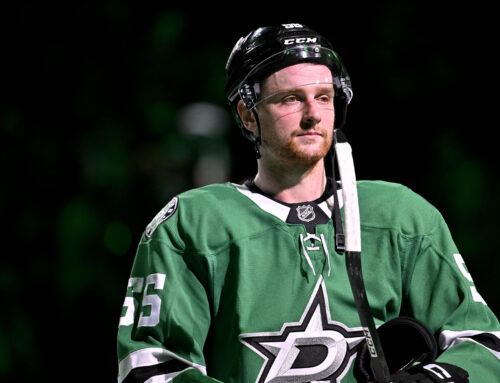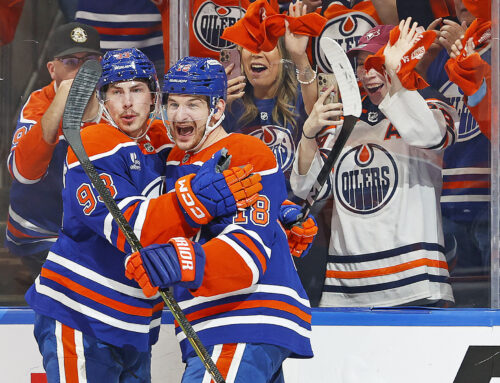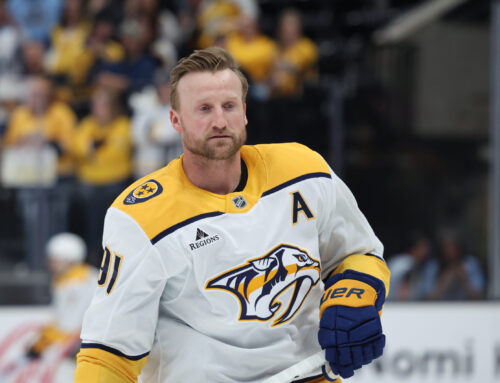
Welcome to Week 9 of our summer series. Like last season, this series is intended to take a look at the teams in the Western Conference one by one. We will do a short recap of what took place, but the deep dive here will be into the players that helped make it so, for better or worse. We will be taking a look at a few players who out or underperformed their expectations and be considering whether this performance might just be the new normal.
And now for the technical details. We will be using the Fantasy Hockey Geek tool to get a ranking that combines all of a player’s stats for the searched categories. These ranks are based on a 12 team, head-to-head league, using the categories of goals, assists, power-play points, shots, hits and blocks for forwards/defensemen and wins, saves, save percentage and goals against average for goalies. The idea is to compare this ranking with an expected ranking based on the average draft positions from the start of the year. This process does not necessarily identify who was the most important player to each team but gives us not only an idea of who was a steal/bust on draft day, but where each player was valued going into this season. Player eligibility for this series is based on Yahoo, and draft ranks are based on average draft positions compiled from Yahoo, ESPN and CBS by FantasyPros.
This week: Minnesota
Recap
Minnesota finished in last place in the Central Division (10th overall in the West), missing the playoffs. A resurgent Zach Parise was certainly a bright spot, but their aging core struggled to produce in 2018-19. Bringing in Mats Zuccarello and Ryan Hartman may help a bit going into 2019-20, but Minnesota will need a bounce back from some of their older players.
Undervalued
Zach Parise entered the 2018-19 season with quite a few question marks. He had failed to play more than 70 games since 2014-15 and had declining point paces since 2013-14. He was drafted 186th overall, right between Ty Rattie and Craig Smith. By the end of the season he was ranked 110th overall, ahead of guys like Evgenii Dadonov and Jeff Skinner.
|
Player |
Team |
Position |
FHG Rank |
|
CBJ |
RW |
99 |
|
|
NYR |
LW |
108 |
|
|
MIN |
LW |
110 |
|
|
SJS |
C/LW/RW |
111 |
|
|
WPG |
RW |
117 |
Parise’s jump in value came because he did actually jump in value. He was drafted in a pretty reasonable range for what he had been producing – but in 2018-19 he produced much better.
|
GP |
Goals |
Assists |
Points |
Points/ Game |
Shots |
S% |
Hits |
PPPts |
Blocks |
PPTOI |
TOI |
|
74 |
28 |
33 |
61 |
0.82 |
229 |
12.2 |
49 |
16 |
71 |
2:54 |
18:40 |
Right off the bat we should note that he played more games and had more time on ice per game than in the last several years. His time-on-ice numbers are the highest he has had in the last three seasons. It sort of figures that his shot pace was the highest of all of those seasons as well. That holds true for his power-play time on ice as well. It does make sense – give a talented (if aging) player a bigger role and we shouldn’t be surprised he produced at a higher rate.
For 2019-20 the question really does come down to that role and his injury history. Most of the underlying numbers look good. No real red flags indicating that his point pace was unsustainable. Unfortunately, injuries aren’t something we can predict and we don’t necessarily have any guarantee that his increased role will stick. He had the same coach in all of the past three seasons, but clearly got better deployment in 2018-19.
Games played and deployment are outstanding questions that we don’t currently have answers to, but until that gets resolved, a 65-point pace Parise seems completely within the realm of possibilities.
Overvalued
Ryan Donato was drafted 198th overall. He was grabbed a couple of picks after Jake DeBrusk and before Timo Meier. He was taken during the part of the draft where most teams are taking some chances, but Donato clearly did not pan out. He finished the season as the 489th-ranked player.
|
Player |
Team |
Position |
FHG Rank |
|
BUF |
LW |
485 |
|
|
ARI |
RW |
486 |
|
|
MIN |
LW/RW |
489 |
|
|
NYR |
RW |
494 |
|
|
NJD |
LW/RW |
497 |
Donato made a splash at the end of 2017-18 when he joined the Bruins for 12 games. His nine points in those games clearly made an impression and he was drafted with the hopes that he would stick.
It very much did not work out in Boston and his full season numbers definitely bear that out. He played just over 12 minutes a night on average and left Boston with nine points over 34 games.
|
GP |
Goals |
Assists
📢 advertisement:
|
Points |
Points/ Game |
Shots |
S% |
Hits |
PPPts |
Blocks |
PPTOI |
TOI |
|
56 |
10 |
15 |
25 |
0.45 |
139 |
7.2 |
24 |
8 |
21 |
2:04 |
13:42 |
Once he arrived in Minnesota though he started seeing 15 plus minutes of ice time a night on an even-strength line with Eric Staal and Jason Zucker. His fortunes vastly improved with 16 points over 22 games (a 73-point pace).
It is a little hard to know what to do with him for 2019-20. For two straight seasons he joined a team and had a strong finish, but we don’t have a lot of solid data on what a full season will mean for him. In Minnesota he has a shot at strong even-strength deployment, but his power-play usage was down below 40%, which certainly will limit his ceiling. His personal shooting percentage was a bit low (around 6%) though it isn’t exactly clear what we should expect it to be in the future. Unfortunately, his IPP was up at 94% meaning he got a point on 94% of the goals scored while he was on the ice in Minnesota. His career numbers are more in the 50% range, so we should expect that number to fall fairly dramatically.
Donato is 23 and clearly has shown some flashes of potential. We had reason to believe that neither his 2017-18 performance with Boston (nine points in 12 games with a 20% shooting percentage) and his Minnesota performance are not repeatable. I am going to hazard a guess though that he isn’t a 22-point pace player either (his 2018-19 Boston point pace). Given the data we have on hand, and the fact that he is not getting power-play one deployment it is hard to predict anything more than a 50-point ceiling.
Mikko Koivu has been as steady as one could wish for a number of years now. He was drafted 182nd overall between Sam Reinhart and Bo Horvat. By the end of the season, though, his value had cratered, finishing at 527th.
|
Player |
Team |
Position |
FHG Rank |
|
EDM |
C/LW |
525 |
|
|
BUF |
RW |
526 |
|
|
MIN |
C |
527 |
|
|
NSH |
D |
528 |
|
|
CGY |
C |
529 |
The biggest reason for this steep decline in value can be seen almost immediately when looking at his stat line. Mr. Consistency only played 48 games. The last time he played less than 80 was in 2013-14.
|
GP |
Goals |
Assists |
Points |
Points/ Game |
Shots |
S% |
Hits |
PPPts |
Blocks |
PPTOI |
TOI |
|
48 |
8 |
21 |
29 |
0.6 |
89 |
9 |
13 |
12 |
32 |
2:22 |
18:18 |
Essentially the rest of his stat line is pretty well in line with the paces he has been putting up the last several seasons. In Koivu’s case though, that is starting to be a problem. He is 36 years old and has been slowly declining. His point pace hasn’t fallen off a huge cliff but he hasn’t hit a pace of .80 (65-point pace) since 2013-14. He is definitely starting to hover around 50 points and as he continues to age, that pace is going to continue to be difficult to meet.
For 2019-20 it is difficult to be excited about a consistent likely 50-point, 36-year-old center. Injuries definitely start to be a concern so even while his pace may not fall off a cliff, the totals could (like they did in 2018-19). I am likely leaving him be as there are plenty of young 50-point players with higher upside than Koivu.
Thanks for reading.
Next week: Nashville
Previous Team Articles





 FLA
FLA EDM
EDM OTT
OTT NYR
NYR CHI
CHI BUF
BUF CAR
CAR WSH
WSH SEA
SEA
